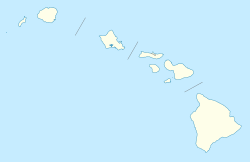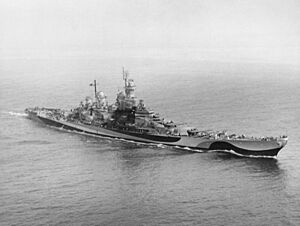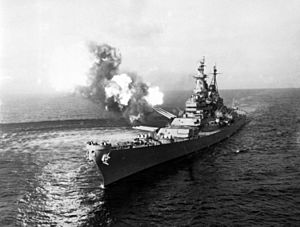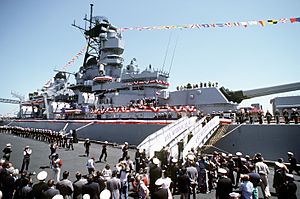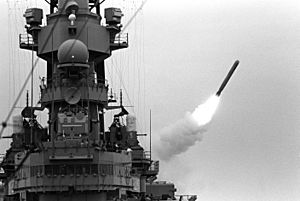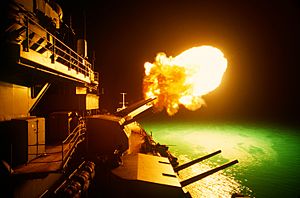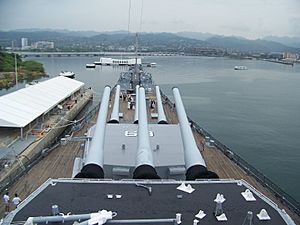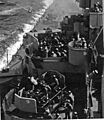USS Missouri (BB-63) facts for kids
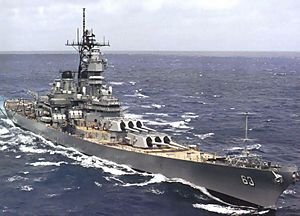
Missouri at sea in her 1980s configuration
|
|
Quick facts for kids History |
|
|---|---|
| Namesake | State of Missouri |
| Ordered | 12 June 1940 |
| Builder | Brooklyn Navy Yard |
| Laid down | 6 January 1941 |
| Launched | 29 January 1944 |
| Sponsored by | Margaret Truman |
| Commissioned | 11 June 1944 |
| Decommissioned | 26 February 1955 |
| Identification | |
| Recommissioned | 10 May 1986 |
| Decommissioned | 31 March 1992 |
| Stricken | 12 January 1995 |
| Motto | "Strength for Freedom" |
| Nickname(s) | "Mighty Mo" |
| Status | Museum ship in Pearl Harbor |
| Badge |  |
| General characteristics (as built) | |
| Class and type | Iowa-class battleship |
| Displacement | 57,540 long tons (58,460 t) (full load) |
| Length | 887 ft 3 in (270.4 m) (o/a) |
| Beam | 108 ft 2 in (33 m) |
| Draft | 37 ft 9 in (11.5 m) |
| Installed power |
|
| Propulsion |
|
| Speed | 32.5 knots (60.2 km/h; 37.4 mph) |
| Range | 15,000 nmi (28,000 km; 17,000 mi) at 15 knots (28 km/h; 17 mph) |
| Complement | 117 officers, 1,804 enlisted men (designed) |
| Sensors and processing systems |
|
| Armament |
|
| Armor |
|
| General characteristics (1986) | |
| Complement | 1,515 officers and enlisted men |
| Sensors and processing systems |
|
| Electronic warfare & decoys |
|
| Armament |
|
|
USS Missouri (BB-63)
|
|
| Location | Pearl Harbor, Hawaii |
| Built | 1944 |
| NRHP reference No. | 71000877 |
| Added to NRHP | 14 May 1971 |
The USS Missouri (BB-63) is a famous battleship that was built for the United States Navy in the 1940s. It's often called "Mighty Mo." This ship was the last battleship ever put into service by the United States. Today, it's a museum ship in Pearl Harbor, Hawaii.
Missouri played a big part in World War II. It helped in important battles like Iwo Jima and Okinawa. Most famously, the surrender of Japan, which ended World War II, happened on its deck on September 2, 1945.
After World War II, Missouri went on many important missions. It served in the Korean War from 1950 to 1953, firing its powerful guns to support ground troops. It was then put into a "mothball fleet" for many years.
In the 1980s, Missouri was brought back to life and updated with modern missiles. It served again in the Persian Gulf during Operation Desert Storm in 1991. After a long and important career, the ship was retired in 1992.
Contents
The Iowa-Class Battleship
The Iowa class of battleships was designed in the late 1930s. These were the last and largest battleships built by the United States. They were also the fastest of their kind.
The Missouri is about 887 feet 3 inches (270.4 m) long, which is longer than three football fields! It's 108 feet 2 inches (33 m) wide. The ship is powered by four steam turbines, which use steam from eight boilers. These engines gave the ship a top speed of about 32.5 knots (60.2 km/h; 37.4 mph) (about 37 miles per hour).
The ship was designed to carry a crew of about 117 officers and 1,804 sailors. By the end of World War II, its crew had grown to nearly 3,000 people.
Ship's Weapons and Radar
The main weapons of the Missouri were nine huge 16 in (406 mm) guns. These were in three gun turrets. Each gun could fire shells weighing as much as a small car! It also had twenty smaller 5 in (127 mm) guns.
For defense against aircraft, the ship had many 40 mm and 20 mm anti-aircraft guns.
The ship used special radar systems to find targets and aim its guns. These included early-warning radar to spot distant aircraft and surface-search radar to find ships. Fire-control radar helped aim the big guns very accurately.
In the 1980s, when Missouri was updated, many of its old anti-aircraft guns were removed. New weapons were added, including:
- Tomahawk cruise missiles: These could hit targets far away on land.
- Harpoon anti-ship missiles: These were used to attack enemy ships.
- Phalanx CIWS: These fast-firing guns could shoot down incoming missiles or aircraft.
Ship's Protection and Armor
Battleships like Missouri had strong armor to protect them from enemy attacks. The ship had a thick armor belt around its waterline, which is the part of the hull that sits in the water. This belt was about 12.1 inches (307 mm) thick.
The main gun turrets also had very thick armor, up to 19.5 inches (495 mm) on their front. The ship's decks were also armored to protect against bombs and shells coming from above.
To protect against torpedoes, the Missouri had several watertight compartments along its sides. These were designed to absorb the blast of a torpedo and prevent water from flooding the main parts of the ship.
Building the Mighty Mo
Missouri was the third US Navy ship named after the state of Missouri. Congress approved its construction in 1938. Its keel was laid down (the first part of the ship was built) on January 6, 1941, at the Brooklyn Navy Yard.
The ship was launched on January 29, 1944. Thousands of people watched. Margaret Truman, the daughter of then-Senator Harry S. Truman, christened the ship. She was the ship's sponsor.
Missouri was officially put into service on June 11, 1944. After some tests and training, it sailed to the Pacific Ocean to join the war effort.
World War II Service (1944–1945)
In January 1945, Missouri joined the US fleet in the Pacific. It helped protect aircraft carriers during air attacks on Tokyo, Japan. The ship's anti-aircraft guns were used to shoot down enemy planes.
The battleship then moved to support the invasion of Iwo Jima in February. It also took part in the Okinawa campaign. On April 11, 1945, a Japanese kamikaze plane hit Missouri. The plane broke apart, causing a small fire, but the ship was only lightly damaged and stayed in action.
In the summer of 1945, Missouri joined other ships in bombarding targets on the Japanese Home Islands. This included industrial areas and airfields.
Japan's Surrender on Missouri

After the atomic bombing of Nagasaki on August 9, 1945, Japan announced its intention to surrender. The USS Missouri was chosen as the place for the official surrender ceremony.
On September 2, 1945, in Tokyo Bay, the surrender ceremony took place on Missouri's deck. General of the Army Douglas MacArthur, representing the Allied forces, accepted the surrender from Japanese officials. This historic event officially ended World War II.
After the ceremony, Missouri helped bring American soldiers home as part of Operation Magic Carpet. It then sailed to the East Coast of the United States.
Post-War Missions (1946–1950)
In 1946, Missouri carried the remains of the Turkish Ambassador back to Turkey. Its visit to Istanbul and then Greece was a symbol of American support for these countries during a time of tension with the Soviet Union.
The ship took part in many training exercises in the Atlantic Ocean and Caribbean Sea. In 1947, President Truman boarded Missouri in Rio de Janeiro to celebrate the signing of the Rio Treaty. This treaty meant that an attack on one American country would be seen as an attack on all.
In 1948, Missouri became the first battleship to have a helicopter detachment. It used helicopters for rescue and other tasks.
The 1950 Grounding Incident
On January 17, 1950, Missouri ran aground (got stuck) in Chesapeake Bay. This happened during a training exercise. It took several weeks and a lot of effort from tugboats and other equipment to free the massive ship. After repairs, the ship's captain and some officers faced a court-martial for the incident.
Korean War Service (1950–1953)
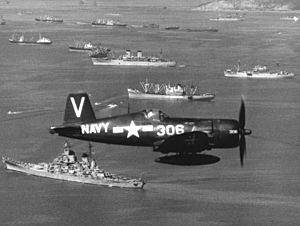
When the Korean War began in 1950, Missouri was quickly sent to support United Nations forces. It was the first American battleship to arrive in Korean waters.
Missouri became a flagship for several admirals. It fired its powerful 16-inch guns in many shore bombardments. These attacks helped support ground troops and destroy enemy positions. The ship also protected aircraft carriers.
During the Hungnam evacuation in December 1950, Missouri provided gunfire support as UN troops retreated. It continued to bombard enemy targets along the Korean coast until March 1953. During its time in Korea, Missouri fired thousands of 16-inch and 5-inch shells.
In March 1953, the ship's commander, Captain Warner Edsall, sadly passed away from a heart attack while guiding the ship.
After its second tour in Korea, Missouri returned to the US. It took part in a midshipman training cruise in 1954, sailing with all three of its sister ships for the only time.
On February 26, 1955, Missouri was officially retired and placed in the reserve fleet at Puget Sound Naval Shipyard. It became a popular tourist attraction, drawing many visitors each year.
Reactivation and Modernization (1984–1990)
In the 1980s, as part of a plan to build a larger US Navy, Missouri was brought back into service. It was towed to Long Beach Naval Shipyard in 1984 for a major upgrade.
During this modernization, many of its older weapons were removed. New cruise missile and anti-ship missile launchers were installed. Its radar and electronic systems were also updated. The ship's crew size was reduced to about 65 officers and 1,450 sailors.
Missouri was officially recommissioned on May 10, 1986, in San Francisco. Margaret Truman, who had christened the ship, was there again.
Later that year, Missouri sailed on an around-the-world cruise. It was the first American battleship to do so in 80 years. In 1987, it was sent to the Persian Gulf to protect oil tankers during a time of tension with Iran. The ship's powerful systems kept watch on Iranian missile launchers.
In 1989, Missouri took part in a large naval exercise with other countries. It showed off its firepower by firing many 16-inch and 5-inch shells.
Gulf War Service (1991)
In August 1990, Iraq invaded Kuwait. The US and other countries sent forces to the Persian Gulf. Missouri was prepared for combat and sent to the region.
On January 17, 1991, Missouri launched its first Tomahawk missiles at Iraqi targets. Over the next few days, it fired many more.
The battleship also used its 16-inch guns to bombard Iraqi command centers and defenses along the Kuwaiti coast. This was the first time its big guns had been used in combat since the Korean War.
On February 23, 1991, during a fake amphibious landing, Missouri fired 133 shells at Iraqi positions. The Iraqis tried to attack Missouri with two Silkworm missiles. One missile failed, and the other was shot down by a British destroyer protecting Missouri. The battleship then used its drones to find and destroy the Iraqi missile launchers.
During the war, Missouri also helped clear Iraqi naval mines. By the end of the conflict, it had destroyed at least 15 mines. The ship fired a total of 783 sixteen-inch shells and 28 Tomahawk missiles during the Gulf War.
After the war, Missouri returned home in April 1991. It hosted President George H. W. Bush in December 1991 to mark the 50th anniversary of the Attack on Pearl Harbor.
Missouri as a Museum Ship (1998 to Present)
With the end of the Cold War, the US Navy decided to reduce its fleet. Maintaining battleships was very expensive. So, Missouri was decommissioned (taken out of service) on March 31, 1992, at Long Beach.
After being in the reserve fleet for several years, Missouri was donated to the USS Missouri Memorial Association in 1998. It was towed to Pearl Harbor, Hawaii, and opened as a museum ship on January 29, 1999.
Missouri is now docked near the USS Arizona Memorial. The Arizona was sunk during the attack on Pearl Harbor, which started World War II for the US. Having Missouri (where the war ended) near the Arizona (where it began) creates a powerful historical connection. Missouri is positioned to face the Arizona Memorial, showing that it watches over the fallen.
In 2009, Missouri went into drydock for a three-month overhaul. This work included repainting its hull and upgrading internal systems. The ship reopened in January 2010. In 2018, more restoration work was done on its upper decks.
Awards and Honors
Missouri earned many awards for its service:
- Three battle stars for World War II
- Five battle stars for the Korean War
- Three battle stars for the Gulf War
It also received other honors, including:
| 1st row | Combat Action Ribbon | Navy Unit Commendation | |||||
|---|---|---|---|---|---|---|---|
| 2nd row | Meritorious Unit Commendation | Navy "E" Ribbon with Wreathed Battle E device | China Service Medal |
|---|---|---|---|
| 3rd row | American Campaign Medal | Asiatic-Pacific Campaign Medal with three campaign stars | World War II Victory Medal |
| 4th row | Navy Occupation Service Medal | National Defense Service Medal with service star | Korean Service Medal with silver service star (5 campaigns) |
| 5th row | Armed Forces Expeditionary Medal | Southwest Asia Service Medal with two campaign stars | Sea Service Deployment Ribbon with two service stars |
| 6th row | Republic of Korea Presidential Unit Citation | United Nations Service Medal | Liberation of Kuwait Medal |
Images for kids
-
A kamikaze plane moments before striking Missouri's side.
See also
 In Spanish: USS Missouri (BB-63) para niños
In Spanish: USS Missouri (BB-63) para niños
- List of museum ships
- U.S. Navy memorials


